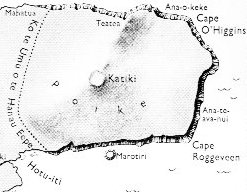There is more to say of course, there always is. In order to keep track of time over the year it could be debated whether to look at the sky in the early morning to find out which constellation or star is rising heliacally, or whether to look in the evening to find out which constellation or star the sun goes down with. Neither alternative is very good, because you must do such observations at a certain time and you must not look straight in the face of Sun. Maka wela the Hawaiians said, your eyes will be burnt: ... Like the sun, chiefs of the highest tabus - those who are called 'gods', 'fire', 'heat', and 'raging blazes' - cannot be gazed directly upon without injury. The lowly commoner prostrates before them face to the ground, the position assumed by victims on the platforms of human sacrifice. Such a one is called makawela, 'burnt eyes' ... You could avoid looking Sun in the eye by observing which star was rising before Sun (or descended after Sun in the evening). However, there is another complication: ... Colonists who arrived in New Zealand from Central Polynesia during the Middle Ages and intermarried with the tangata whenua, 'people of the land', found themselves between the horns of a calendrical dilemma. They must either convert the aborigines to the Pleiades year beginning in November-December or themselves adopt the Rigel year [together with heliacal rising observations] and bring down the wrath of their ancestors on their own heads ... A star will rise in the early morning at different times depending on the latitude of the observer. Makemson thought the Rigel year was a consequence of some island 10º south of the equator: ... can be explained only on the assumption that the very first settlers ... brought the Rigel year with them ... some other land 10° south of the equator where Rigel acquired at the same time its synonymity with the zenith .. I am not convinced. The Gilbertese sky dome said Rigel was located at 8º S, Antares at 26º S, and the Pleiades at 24º N, numbers filled to the brim with other 'sacred' meanings:
Once (in pyramid times) Sun reached to 24º on either side of the equator. 8 is the 'perfect number', and 26 is twice 13 (and also where Easter Island is located). The Gilbertese had all 3 numbers correct, including Rigel at 8º S. They were careful with the details. Moving across the vast ocean with an orientation 2º wrong would spell 'disaster'. However, when observing a star rising it was necessary to know the latitude of the observer, to compensate for the curvature of the earth. To relate the position of a star which is rising (or going down) to the local horizon is possible, but not a very good method. Not for a people making voyages up and down the latitudes. But there is an ingenous method to determine the time of the year independent of latitude or other local phenomena (such as mountains hiding the horizon), viz. to use the moon. When there is a full moon we know there is a straight line between moon and sun and with us somewhere in the middle. A full moon can be seen from all latitudes, the moon is so distant that the latitude of the observer is insignificant. If the observer knows his starry sky well, he will immediately be able to determine which location the full moon occupies, i.e. which stars are close. Then by a quick mental operation he will twirl the starry globe in his head to find the 'antipodal' point in which sun must be, which 'station' on the path of the year sun is in, what the time of the year is. This method gives the same result irrespective of latitude. The method is described by Worthen. I remembered this when reflecting on why piki appears in item 24. Watching the shadows created by the rays of Sun is similar to watching the full face of Moon. There is a straight line connecting a shadow with its source, likewise the illuminated face and its source. The double calendar system of India could have been used also in the rongorongo texts. The appearance of the 3 bird islets outside Rano Kau (at the beginning of spring) appears to be reflected in the 3 'peaks' of Maunga Teatea (not far from Rano Raraku):
Kau means midnight according to Fornander. At the other end we find noon (Ao-akea). Akea can be transcribed as atea, presumably the central 'daytime' of Sun. The double form (teatea) means 'heavy rain' according to the Mangarevans, which indeed agrees with what we have understood comes at the 'back side' (side 2 of a 'tablet'). Ehu ûa (not far from Rehua) means drizzle. Maybe Maunga Teatea should be crossed from right to left. The last of the 'front side' would then be item 24 (Mahatua). In the G text day 240 is at Gb1-10 and 1-10 is the same number as in Aa1-10:
|








